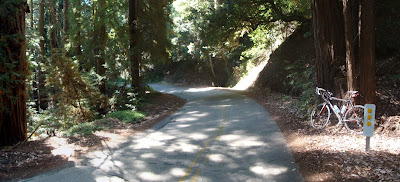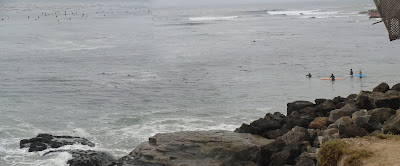View Hecker Pass in a larger map
| Uvas Reservoir |
The Hecker Pass Highway, or Route 152, links Gilroy with Watsonville across the southern end of the Santa Cruz mountains. It has a poor reputation as a road for bicycling, but it's hard to know how to take that, since some bicyclists are just uncomfortable around traffic. My only experience with Hecker Pass was a sightseeing drive I took several years ago, and I remembered it as a twisty, narrow road.
I started out about 8:30 AM yesterday. The fog was burning off as I went down the Almaden Expressway to McKean, which turns into Uvas Road. It was nonetheless a cool, beautiful day for a ride, and this opinion was apparently shared by the dozens of riders out there with me. Today was a day for club rides, which meant riders passed me in ones and twos on the hills, and then in large groups on the flats.
It was on Uvas Road that I saw the day's closest encounter between a car and a bike. One of the club riders was just ahead of me and a champagne-colored Cadillac brushed by a few inches from him. From my vantage point I was sure he was hit. No oncoming traffic; it just looked like the Cadillac didn't feel like moving over.
The last time I came down here I explored all the side roads, so this time I was a little surprised to find myself down by the Uvas Reservoir after only 20 miles of riding.
 |
| Uvas Reservoir and the lone Twin Peak |
 |
| Hecker Pass Highway |
The road, I must say, is not a bicycle road. Aside from the rare turn-off area, the shoulder is a consistent 6 inches, all the way up (the shoulder shown in the photo is typical).
On the positive side, I don't recall any stretches with no shoulder at all, or especially skinny lanes. There was a fair amount of traffic; I'm guessing I got passed by a hundred or so cars. I had no close calls, honking or other drama. This is all actually OK for me, but if you're ever uncomfortable on roads, you should probably find an alternative.
Just beyond the marker is something called the Mt Madonna Inn. There was also a path leading toward a great view of Watsonville, near some decaying cabins.
 |
| Cabins behind Mount Madonna Inn, with Watsonville in the background |
 |
| Pole Line Road |
The fog was still thick on Mount Madonna, visibly rolling over the trees onto the road. It was condensing in the trees and then dripping, creating a reverse-rain effect: wet under the tree canopy, but dry elsewhere.
I rode through the park and my legs were really starting to feel tired. Well, there would be a lot of downhill on which to recharge, at least.
 |
| Fog in Mount Madonna Park |
|
|
By this point it was about noon, and my target was lunch at the Corralitos Market. At the bottom of Mt Madonna Road I took a right onto Hazel Dell Road, which runs through the woods, climbs a bit of a hill, and at some point turns into Brown Valley Road. Brown Valley Road runs right to the market. There were dozens of cars parked up the road from the market, apparently for some sort of reunion.
My legs were awfully sore, and I still had to get back over the mountain to get home. So I took my time eating lunch.
I got back on the bike and slowly headed up Eureka Canyon Road, feeling very weak on the climbs. Eventually I got to the intersection with Buzzard Lagoon Road, where Eureka Canyon turns into Highland. This is a high point in the road at nearly 1900 feet. Highland immediately drops about 300 feet before climbing right back up to 1900 feet very near the site of this spring's mudslide. This was the peak of this ride. After this high point Highland wiggles along, mostly level, then drops 200 feet or so to meet Summit.
I stopped at the Summit Store for a drink, then went down Old Santa Cruz Highway to Los Gatos, and finally over Blossom Hill Road toward my house.
After a day on Uvas Road and Hecker Pass Highway and all sorts of one-lane roads, it was here on Blossom Hill Road that I had my closest encounter with a car. And not on the skinny part of the road thats heads over the hill, either -- it was east of that, on the four lane road with generous parking lanes. The car was following an SUV pretty closely, so they probably never even saw me. The suburbs are murder.
 |
| Elevation profile See a note about data for details |
The ride was a little over 76 miles, which is awfully long for me. The Garmin gave me 5800 feet of climbing, although the real number of probably closer to 4500. Still, the Garmin result shows the value of the elevation correction done by the Garmin Connect web site. Out on the road the elevation reading was a random number generator, fluctuating by 100s of feet on steady climbs. The raw data, with the elevation correction turned off, gave me 14000 feet of climbing.
I suspect the estimate of calories burned is based on the raw data, because it thought I burned 12000 calories. If I had done that, I'd be dead.
Today was a great ride. It was my longest ride in years, and one of the few times I've managed to cross the mountains over and back. I'm getting to the point where I can get a little more ambitious in my routes. My options are expanding.















